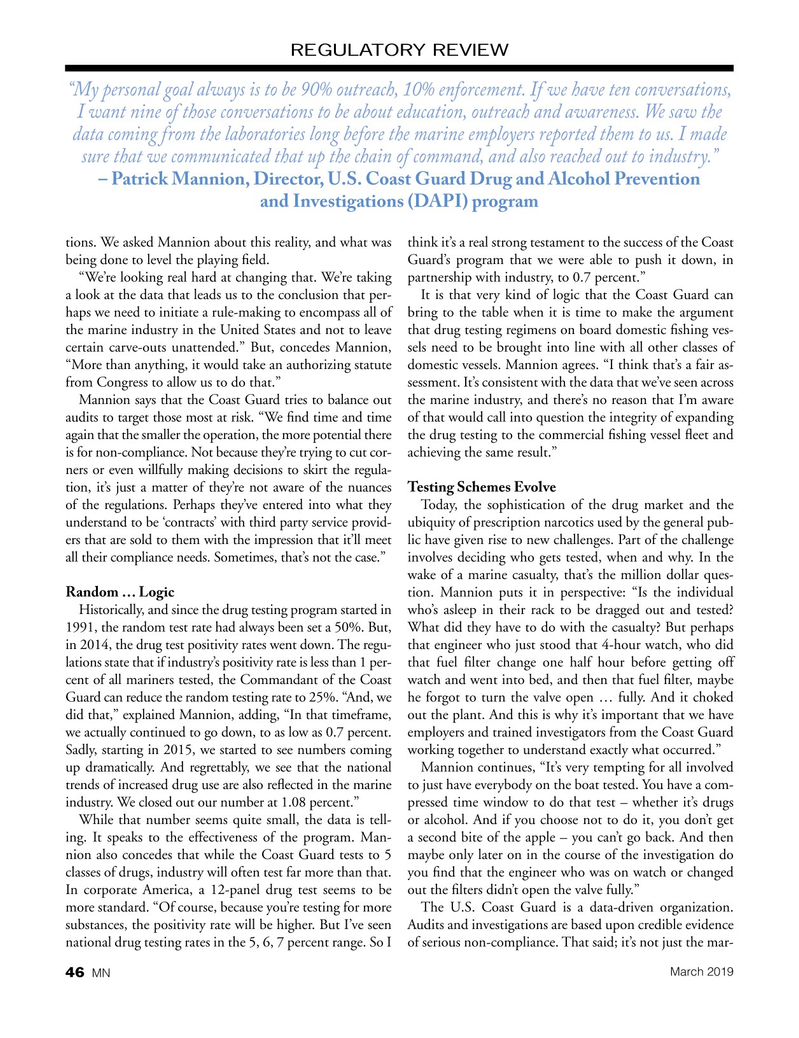
Page 46: of Marine News Magazine (March 2019)
Pushboats, Tugs & Assist Vessels
Read this page in Pdf, Flash or Html5 edition of March 2019 Marine News Magazine
REGULATORY REVIEW “My personal goal always is to be 90% outreach, 10% enforcement. If we have ten conversations,
I want nine of those conversations to be about education, outreach and awareness. We saw the data coming from the laboratories long before the marine employers reported them to us. I made sure that we communicated that up the chain of command, and also reached out to industry.” – Patrick Mannion, Director, U.S. Coast Guard Drug and Alcohol Prevention and Investigations (DAPI) program tions. We asked Mannion about this reality, and what was think it’s a real strong testament to the success of the Coast being done to level the playing feld. Guard’s program that we were able to push it down, in “We’re looking real hard at changing that. We’re taking partnership with industry, to 0.7 percent.” a look at the data that leads us to the conclusion that per- It is that very kind of logic that the Coast Guard can haps we need to initiate a rule-making to encompass all of bring to the table when it is time to make the argument the marine industry in the United States and not to leave that drug testing regimens on board domestic fshing ves- certain carve-outs unattended.” But, concedes Mannion, sels need to be brought into line with all other classes of “More than anything, it would take an authorizing statute domestic vessels. Mannion agrees. “I think that’s a fair as- from Congress to allow us to do that.” sessment. It’s consistent with the data that we’ve seen across
Mannion says that the Coast Guard tries to balance out the marine industry, and there’s no reason that I’m aware audits to target those most at risk. “We fnd time and time of that would call into question the integrity of expanding again that the smaller the operation, the more potential there the drug testing to the commercial fshing vessel feet and is for non-compliance. Not because they’re trying to cut cor- achieving the same result.” ners or even willfully making decisions to skirt the regula- tion, it’s just a matter of they’re not aware of the nuances Testing Schemes Evolve of the regulations. Perhaps they’ve entered into what they Today, the sophistication of the drug market and the understand to be ‘contracts’ with third party service provid- ubiquity of prescription narcotics used by the general pub- ers that are sold to them with the impression that it’ll meet lic have given rise to new challenges. Part of the challenge all their compliance needs. Sometimes, that’s not the case.” involves deciding who gets tested, when and why. In the wake of a marine casualty, that’s the million dollar ques-
Random … Logic tion. Mannion puts it in perspective: “Is the individual
Historically, and since the drug testing program started in who’s asleep in their rack to be dragged out and tested? 1991, the random test rate had always been set a 50%. But, What did they have to do with the casualty? But perhaps in 2014, the drug test positivity rates went down. The regu- that engineer who just stood that 4-hour watch, who did lations state that if industry’s positivity rate is less than 1 per- that fuel flter change one half hour before getting off cent of all mariners tested, the Commandant of the Coast watch and went into bed, and then that fuel flter, maybe
Guard can reduce the random testing rate to 25%. “And, we he forgot to turn the valve open … fully. And it choked did that,” explained Mannion, adding, “In that timeframe, out the plant. And this is why it’s important that we have we actually continued to go down, to as low as 0.7 percent. employers and trained investigators from the Coast Guard
Sadly, starting in 2015, we started to see numbers coming working together to understand exactly what occurred.” up dramatically. And regrettably, we see that the national Mannion continues, “It’s very tempting for all involved trends of increased drug use are also refected in the marine to just have everybody on the boat tested. You have a com- industry. We closed out our number at 1.08 percent.” pressed time window to do that test – whether it’s drugs
While that number seems quite small, the data is tell- or alcohol. And if you choose not to do it, you don’t get ing. It speaks to the effectiveness of the program. Man- a second bite of the apple – you can’t go back. And then nion also concedes that while the Coast Guard tests to 5 maybe only later on in the course of the investigation do classes of drugs, industry will often test far more than that. you fnd that the engineer who was on watch or changed
In corporate America, a 12-panel drug test seems to be out the flters didn’t open the valve fully.” more standard. “Of course, because you’re testing for more The U.S. Coast Guard is a data-driven organization. substances, the positivity rate will be higher. But I’ve seen Audits and investigations are based upon credible evidence national drug testing rates in the 5, 6, 7 percent range. So I of serious non-compliance. That said; it’s not just the mar-
March 2019 46 MN

 45
45

 47
47
